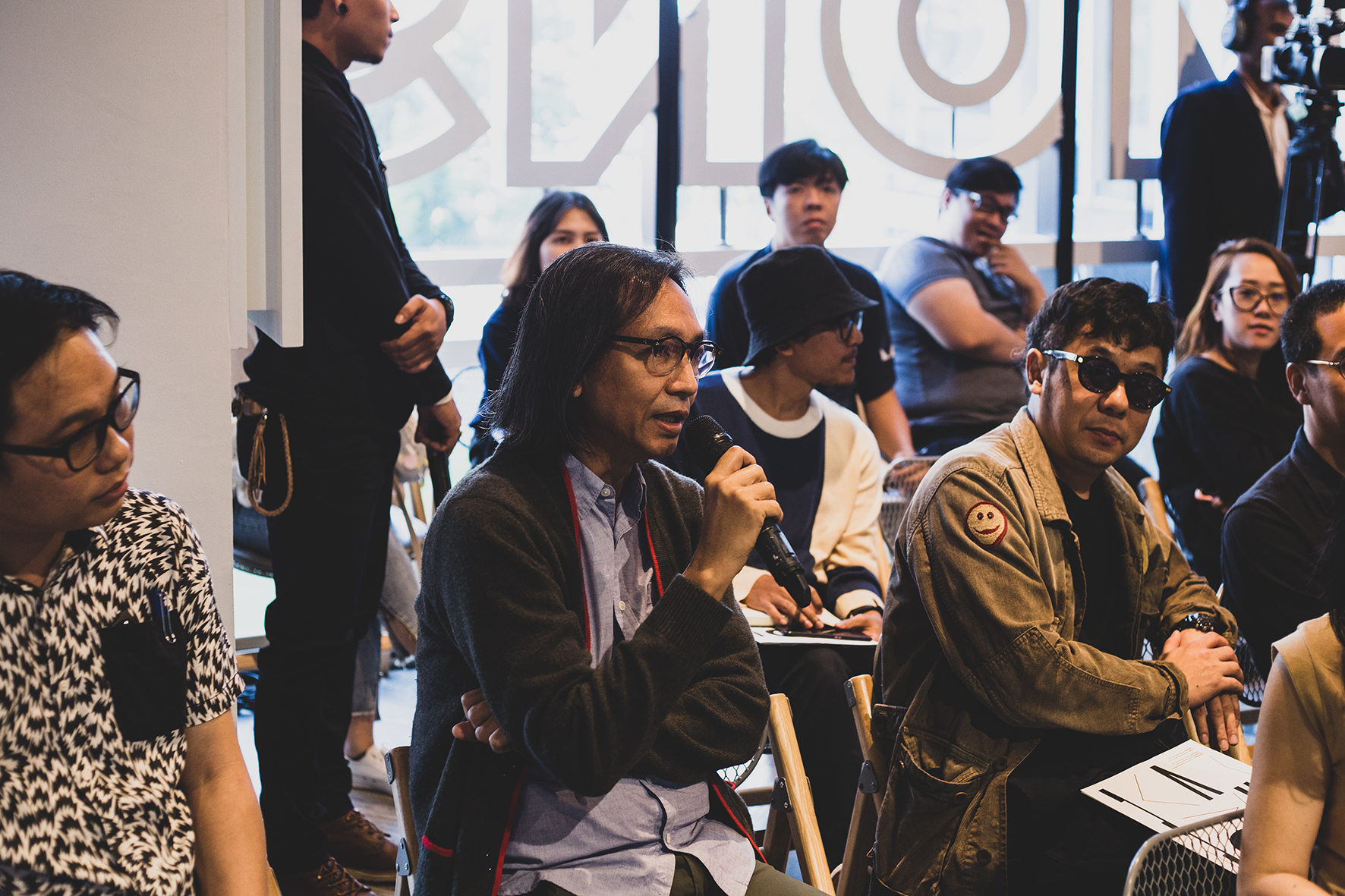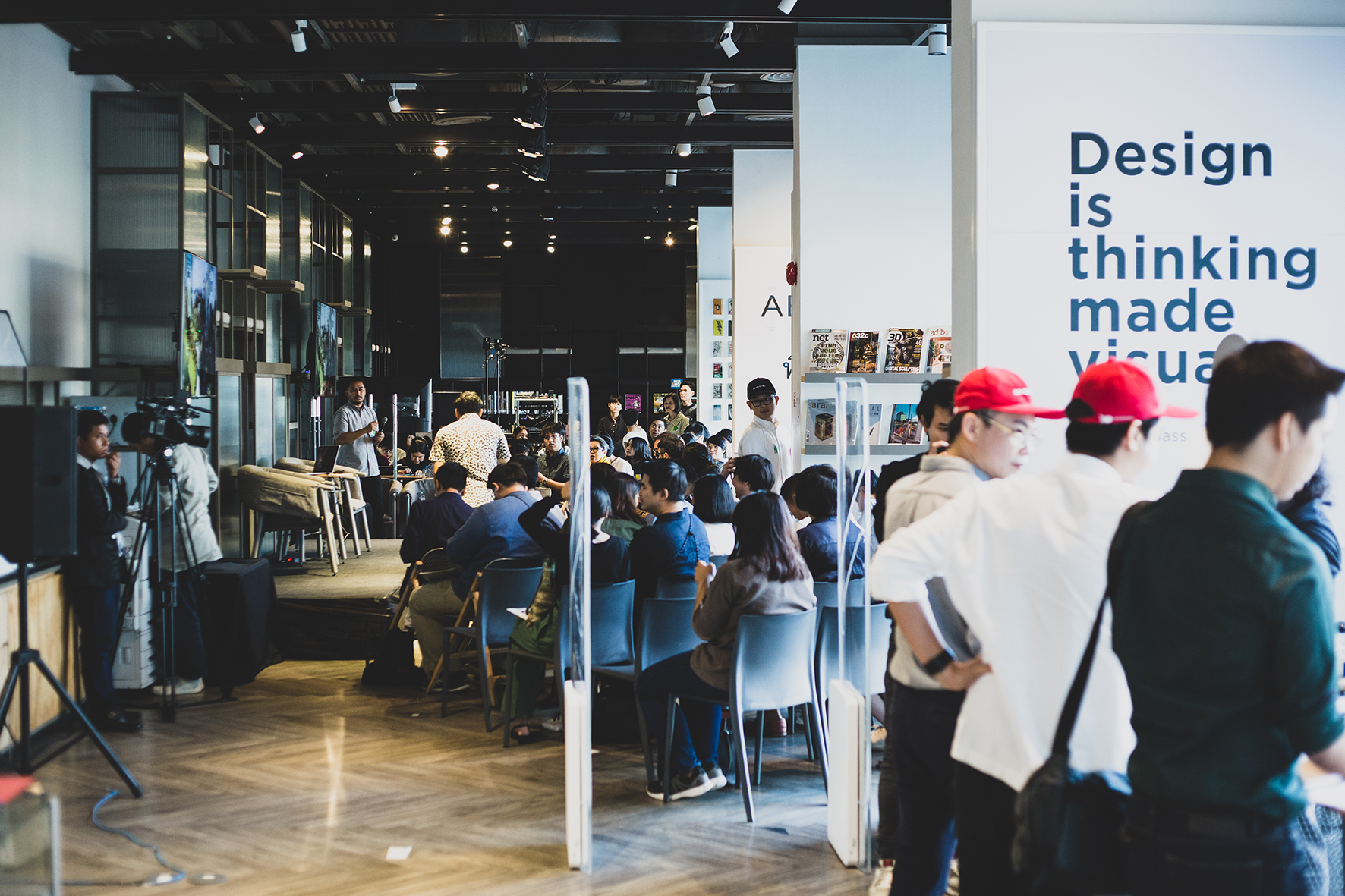LEAD BY SANTI LAWRACHAWEE AND COUNTLESS PROMINENT THAI DESIGNERS, ‘MOVE’ HAS MADE ITS 1ST, ORGANIZING A ROUNDTABLE DISCUSSION FOR THOSE CONCERNED WITH THE FUTURE OF DESIGN EDUCATION
TEXT: TECHIT JIROPASKOSOL
PHOTO COURTESY OF MOVE
(For English please scroll down)
ในปัจจุบันที่แทบทุกมหาวิทยาลัยมีคณะสอนวิชาการออกแบบ ในชื่อภาควิชาและหลักสูตรการเรียนการสอนที่แตกต่าง สร้าง(ศักย)ภาพการแข่งขันผ่านเอกลักษณ์ทางการศึกษาเพื่อดึงดูดนักเรียนมัธยมจบใหม่มาเรียนที่สถาบันของตัวเองให้ได้มากที่สุด ทั้งที่ความเป็นจริงแล้วหลักการออกแบบ (Design Principles) มีหลักใหญ่ๆ อยู่เพียงไม่กี่ข้อ การเกิดขึ้นของ M>O>V>E> โดยสันติ ลอรัชวี แห่ง Practical Design Studio จึงนับว่าเป็นเรื่องที่ควรค่าแก่การให้ความสนใจไม่น้อย พวกเขาตั้งใจให้ M>O>VE> เป็นพื้นที่สื่อกลางในการช่วยกันพัฒนามาตรฐานวิชาการด้านการออกแบบอย่างมีส่วนร่วม เพื่อร่วมกันก้าวข้าม “การวัดคุณค่าผ่านวิธีนับค่าหัวนักศึกษา” กลับมาสู่เหตุผลที่แท้จริงนั่นคือการถ่ายทอดแลกเปลี่ยนและทดลองขอบเขตของความเป็นไปได้

M>O>V>E> เปิดตัวด้วยภาพจำที่หนักแน่นแต่ยืดหยุ่นด้วยการใช้ typography แบบ variable logo ที่กำลังอยู่ในกระแสนิยมของวงการออกแบบ ไม่เสียทีที่ออกแบบและพัฒนาโดย Means Studio และ Studio Craftmanship ที่มีพื้นฐานมาจากการออกแบบกราฟิคและภาพเคลื่อนไหว ไม่นานหลังจากการเปิดตัวก็ตามมาติดๆ ด้วยกิจกรรมวงเสวนาแลกเปลี่ยนความคิดเห็นในวันที่ 17 ธันวาคมเมื่อปีที่ผ่านมา ในงานเต็มไปด้วยนักคิดนักออกแบบที่มีชื่อเสียงในวงการเดินชนกันให้ขวักไขว่ ทำให้พื้นที่จัดกิจกรรม TCDC Commons Samyan by IDEO ดูเล็กลงไปถนัดตา
นำขบวนด้วยภิญโญ ไตรสุริยธรรมา บรรณาธิการสำนักพิมพ์ Open Book สาธิต กาลวันตวานิช ผู้ร่วมก่อตั้งบริษัทโฆษณา Phenomena และแบรนด์ Propaganda อนุทิน วงศ์สรรคกร ผู้ก่อตั้ง “คัดสรร ดีมาก” นนทวัฒน์ เจริญชาศรี หัวเรือใหญ่แห่ง DUCTSTORE the Design Guru กัลยา โกวิทวิสิทธิ์ ผู้ร่วมก่อตั้ง FabCafe Bangkok และ FABLAB และนักออกแบบทั้งรุ่นใหม่รุ่นเก๋าอีกมากมายซึ่งคงไล่เรียงได้ไม่หมดตรงนี้ ปฏิเสธไม่ได้ว่าการมารวมตัวกันของบุคคลเหล่านี้ทำให้ M>O>V>E น่าจับตามอง แต่ก็ไม่ได้เรียกร้องความสนใจให้กับผู้เขียนได้มากเท่ากับการได้เห็นตัวละครอื่นๆ อย่างนักวิชาการ อาจารย์คณะออกแบบจากหลายๆ สถาบัน ทั้งคณบดี รองคณบดี หัวหน้าภาควิชา ออกมารวมตัวกันนอกสถานที่ (การนัดเจอบุคคลที่มีตำแหน่งและความรับผิดชอบระดับนี้ไม่ใช่เรื่องง่าย) น่าจะเรียกได้ว่านี่เป็นครั้งแรกที่มีการรวมตัวกันของนักการศึกษาในวงการออกแบบจำนวนมากระดับนี้ สำหรับผู้เขียนเห็นว่าเป็นจุดเริ่มต้นของการ “เคลื่อน” ที่มีความหวัง
กิจกรรมในวันเสวนาเริ่มต้นตั้งแต่เช้าตรู่ เสวนาช่วงแรกดำเนินรายการโดย สันติ ลอรัชวี และภิญโญ ไตรสุริยธรรมา ในหัวข้อ “Design&Future” นับว่าเป็นการจับคู่ที่เหมาะเจาะ เพราะนอกจากทั้งคู่จะมีหน้าตาและบุคลิกที่ละม้ายคล้ายเป็นพี่น้องกันแล้ว พื้นฐานองค์ความรู้ของทั้งคู่ก็เรียกได้ว่าสอดรับกันอย่างลงตัว ภิญโญ เริ่มต้นด้วยการเล่าเรื่องราวการออกแบบที่แฝงประวัติศาสตร์ของทั้งฝั่งตะวันตกและตะวันออกในเรื่องของ “พื้นที่ว่าง” ตามมาด้วยการแนะให้เห็นถึงอนาคตที่เทคโนโลยีต่างๆ จะเข้ามาอำนวยความสะดวกไม่เว้นแม้กระทั่งการคิดและออกแบบสิ่งต่างๆ แทนมนุษย์ ซึ่งนำไปสู่คำถามที่สำคัญว่า “อะไรคือหัวใจสำคัญของการออกแบบ?” ถ้าหากนักออกแบบยังตอบคำถามนี้ไม่ได้ ก็มีโอกาสที่วิชาชีพนี้จะสูญพันธุ์ไปพร้อมกับการเข้ามาของนักออกแบบปัญญาประดิษฐ์ในที่สุด

ไมโครโฟนได้ถูกส่งต่อมาให้สันติ กับการย้อนกลับไปหาจุดเริ่มต้นของประวัติศาสตร์การออกแบบว่า “มนุษย์ไม่ได้ค้นพบไฟแต่มนุษย์ออกแบบไฟ” — ฟังแล้วคิดตามก็ดูเข้าที เพราะการที่มนุษย์ยุคก่อนประวัติศาสตร์ นำไฟมาไว้ที่กองไม้ก็คือการจัดการความสัมพันธ์ของไฟกับพื้นที่เสียใหม่ให้อยู่ในพื้นที่จำกัด แทนที่จะอยู่ในพื้นที่ที่สามารถไหม้ลุกลามไปเรื่อยๆ ก่อนจะต่อยอดไปถึงความท้าทายที่นักออกแบบทุกสาขา (น่าจะต้อง) เผชิญหน้าในอนาคต แยกออกเป็นความท้าทายด้านการปฏิบัติ ด้านชิ้นงาน และด้านบริบทรอบข้างที่สังคมมีความต้องการที่ซับซ้อนเพิ่มมากขึ้น — ลองจิตนาการตามว่าถ้าลูกค้าในอนาคตทวีความซับซ้อนกว่าปัจจุบัน เราน่าจะมีอนาคตการทำงานที่มืดมนพอสมควร หลังจากนั้นกิจกรรมก็ได้ขยับเข้าสู่ช่วงแลกเปลี่ยนกันของวงใหญ่ครั้งแรก ซึ่งน่าเสียดาย ไม่แน่ใจว่าจะเป็นเพราะด้วยเวลาที่ค่อนข้างสั้นหรือไม่ แต่เวทีการแลกเปลี่ยนครั้งนี้จึงดูคล้ายเป็นพื้นที่แนะนำตัวและปาฐกถาของแขกรับเชิญรุ่นใหญ่ มากกว่าเป็นวงเสวนาแลกเปลี่ยนที่มีความเท่าเทียมอย่างที่หลายคนคาดหวัง
หลังจากพักเบรคทานอาหารกลางวันวงสนทนาช่วงบ่ายดูจะเบาบางลง (คงเป็นเพราะกิจกรรมจัดขึ้นในวันทำงาน) แต่ดีกรีความเข้มข้นก็ไม่ได้ลดลงแต่อย่างใด เนื้อหาของกิจกรรมช่วงบ่ายขยับเข้าสู่หัวข้อ “Innovation&Technology” โดยเริ่มต้นโดย ขวัญชัย อัครธรรมกุล ผู้ก่อตั้ง Studio Craftmanship ที่ขึ้นเวทีมาเล่าถึงประโยชน์ของการทำงานออกแบบผ่านเทคโนโลยีร่วมสมัย ตั้งแต่การใช้งาน Cloud Computing เพื่อบริหารจัดการ ไปถึงการสร้างไวยากรณ์ภาษาคอมพิวเตอร์เพื่อสร้างคำสั่งให้เครื่องประมวลผลผ่านโปรแกรม Processing คำศัพท์เกี่ยวกับนวัตกรรมต่างๆ ถูกอธิบายผ่าน keynote ไล่ไปทีละสไลด์ๆ โดยละเอียด สลับกับที่กัลยา โกวิทวิสิทธิ์ จาก FabCafe Thailand พูดถึงแนวโน้มและตัวอย่างของเทคโนโลยีในอนาคตที่กำลังขยับเข้ามาแนบชิดกับร่างกายมนุษย์มากยิ่งขึ้น ผ่านทางกิจกรรมที่ทุกคนสามารถทำร่วมกันได้ และวิธีการที่เทคโนโลยีสมัยใหม่เชื่อมต่อกับอุปกรณ์พกพาอย่างโทรศัพท์มือถือเพื่อเก็บข้อมูลของผู้ใช้งานได้ตลอดเวลา

ความน่าสนใจในช่วงนี้อยู่ที่วงเสวนาหลังจากการนำเสนอ ความคิดเห็นและคำถามที่หลากหลายจากผู้เข้าร่วมถูกสะท้อนกลับไปยังผู้เสวนาทั้งสองคน โดยเฉพาะความหมายของคำว่า “นวัตกรรม” ในมุมมองและรูปแบบที่นอกเหนือจากเรื่องของเทคโนโลยี และคำถามที่เจาะลงไปในรายละเอียดของเทคโนโลยีแต่ละชนิด ทำให้เกิดพลวัตของการแลกเปลี่ยนเรียนรู้ขยายขึ้นในวงกว้างเมื่อเปรียบเทียบกับวงเสวนาช่วงเช้าอย่างเห็นได้ชัด
ก้อนความคิดเห็นที่เริ่มก่อตัวและมีการกระเพื่อมจากวงเสวนารอบที่สอง ได้ส่งต่อมาถึงวงสนทนาสุดท้ายของกิจกรรมในวันนี้นั่นคือ Design Education ที่เป็นเหมือนใจความสำคัญของโครงการนี้ โดยผู้ร่วมเสวนาผู้ทรงคุณวุฒิทั้ง 4 ท่าน (คณบดี 3 ท่านและผู้ร่วมสร้างหลักสูตรปริญญาโทอีกหนึ่งท่าน) ช่วงแรกของวงเสวนารอบสุดท้ายให้อารมณ์เหมือนกับเข้าไปนั่งในงานปฐมนิเทศของแต่ละคณะเมื่อข้อมูลและวิธีการเรียนการสอนของแต่ละคณะอย่างละเอียด คาดว่าน่าจะเป็นกุศโลบายเพื่อให้ผู้ฟังได้เห็นบริบทของวิธีส่งมอบความรู้ที่ใกล้เคียงกันในรูปแบบที่แตกต่างกัน
วงสนทนาแลกเปลี่ยนที่ออกรสออกชาติในช่วงท้ายสุดของกิจกรรมน่าจะเป็นจุดที่น่าจดจำที่สุด เพราะเป็นช่วงเวลาที่หลายๆ คนได้อนุญาตให้เปลี่ยนบทบาทของตัวเองจากผู้ชม มาเป็นผู้แสดงร่วมบนเวทีของการเสวนา ความเป็นไปได้และอนาคตอันหลากหลายของวงการศึกษาถูกสื่อสารออกมาอย่างน่าสนใจในมิติต่างๆ ทั้งจากมุมมองของนักศึกษามหาวิทยาลัย นักวิชาชีพ นักวิชาการ อย่างไม่มีลำดับชั้นและเงื่อนไขอื่นใดนอกจากความต้องการที่จะพัฒนาวิธีศึกษาการออกแบบของทุกคน จนรู้สึกว่าเวลาที่เตรียมไว้ในช่วงสุดท้ายหมดลงไปอย่างรวดเร็ว
แม้ว่าท้ายที่สุดจะไม่มีผลสรุปหรือแนวทางที่เป็นรูปธรรมออกมาจากวงเสวนาในวันนั้น แต่อย่างน้อย M>O>V>E> ครั้งแรก ก็แสดงให้เห็นว่าหากมีการวางแผนเตรียมงานอย่างมุ่งมั่นตั้งใจเราจะสามารถสร้างการศึกษาเรียนรู้ที่เกิดขึ้นจากวงเสวนาแลกเปลี่ยนที่มีประสิทธิภาพ และการแลกเปลี่ยน (reflection) ในลักษณะนี้เองที่เป็นส่วนสำคัญที่สุดของการศึกษา เหมือนอย่างที่ เปาโล เฟรเร (Paolo Freire) ได้กล่าวเอาไว้ว่า “หากปราศจากบทสนทนาก็ไม่อาจมีการสื่อสาร หากปราศจากการสื่อสารก็ไม่อาจมีการศึกษาที่แท้จริง” หลายสิ่งที่เกิดขึ้นในวันนั้นบอกกับเราว่าการศึกษายังคงเป็นเรื่องที่หลายๆ คนในวงการออกแบบยังให้ความสำคัญอยู่ การศึกษาคือการลงทุนที่ใช้ต้องใช้เวลาบ่มเพาะและไม่มีทางลัดแต่มันเป็นการพัฒนาที่ยั่งยืนที่สุดหากผู้คนในสังคมยังสนใจในการศึกษาและเรียนรู้ที่จะอดทนรอคอยผลที่จะเกิดขึ้นร่วมกัน ในลักษณะเดียวกันกับการเกิดขึ้นของวงสนทนา (จริงๆ) ในช่วงสุดท้าย ถึงแม้ว่าเราจะตกอยู่ภายใต้การบริหารประเทศที่ทำให้ประชาชนมองหาอนาคตได้ไม่ชัดเจนเท่าไหร่ แต่อย่างไรผู้คนก็จะยังไม่หมดซึ่งความหวัง เพราะว่าการศึกษาเป็นจุดเริ่มต้นของการเปลี่ยนแปลงเสมอ

In this day and age when almost every university offers its own design-related courses referred to by different department and program names with vigorously promoted images that aim to attract enrollment from fresh high-school graduates, the reality is the so-called diversity of design education essentially stems from only a few fundamental principles of design. The conception of M>O>V>E> by Santi Lawrachawee of Practical Design Studio is worth one’s attention for its intention to create a platform where new developments regarding educational standards can take place as a participatory process, and ultimately progress beyond the ‘value validated by the number of enrolled students’ to the true rationale of design learning, which is the transpiration, exchange and experimentation of different boundaries of possibility.
M>O>V>E> was launched with a strong yet flexible identity achieved through the use of a variable logo typography that the design industry currently adores. The logo is everything one might expect from a design and development created by Means Studio and Studio Craftsmanship whose extensive backgrounds in graphic and motion design are widely known. Following the logo was the launch of M>O>V>E> itself with the first talk being held on the 17th of December of last year, packing the activity grounds of TCDC Commons IDEO Q Chula – Samyan with an impressive number of attendees from the creative crowd including all the big names in the industry.

Among the familiar faces at the opening night were Pinyo Traisuriyathamma, Editor of Open Book Publishing, Satit Kalawantavanich, co-founder of advertising agency Phenomena and Propaganda, Anuthin Wongsunkakon , the founder of ‘Cadson Demak,’ Nontawat Charoenchasri, director of DUCTSTORE the Design Guru, Kalaya Kovidvisith, co-founder of FabCafe Bangkok and FABLAB, and many more young and veteran designers whose names cannot all be mentioned in this article. It’s undeniable that the assembly put M>O>V>E on the radar, but the long list of the industry’s celebrities didn’t excite us as much as being able to see academics, professors from design departments from various institutes, including the deans, vice deans, and department heads, in attendance at the event (putting together a guest list of people of such positions and responsibilities isn’t easy). This is probably the first time that an event could bring together this impressive number of important figures in design academia, which, at least to us, marks the promising beginning of M>O>V>E.
The activity on the day of the talk started off early in the morning. Santi Lawrachawee and Pinyo Traisuriyathamma kicked off the first segment, followed by a stimulating discussion over ‘Design & Future.’ The pairing was practically a match made in heaven not only for the physical appearances that the two designers share but also their complementary background knowledge and experiences, which interestingly corresponded with the topic. Traisuriyathamma started off with the historical background of space in the context of both the Western and Eastern worlds. He then shared his observation for the future where technologies will offer greater convenience for humans, even to the extent of thinking and designing. Following his observation, Traisuriyathamma raised a question, ‘What is the essence of design?’, discussing the possibility of the design profession being driven into extinction due to the growing ability of AI designers, especially if the actual ‘human’ designers are not able to find the answer to such question.
The microphone was passed on to Lawrachawee who went back to revisit the beginning of the history of design with an observation that “humans didn’t discover but designed fire.” The remark is interesting and made more sense as we contemplated it further. The way that the prehistoric humans chose to lay fire on a tinder bundle or a bunch of wood sticks can be viewed as a way of managing the relationship between fire and space. Instead of an open ground, they made fire within a limited barrier of which they had control over. The idea references the challenge that designers from every discipline of design will likely be confronting in the future. He divided the challenge into the aspect of practice, a work’s physical presence and the context surrounding the work as a result of the society’s demands for complexity. We listened and imagined the future where consumers’ demands become more complicated as well as the challenges design workers have to face. The session then moved on to the discussion and, unfortunately, perhaps due to the limited time they had, the overall talk ended up being somewhat of the two designers’ own introductions and speeches rather than a conversation offering an equal exchange of opinions that many had expected it to be.

After a lunch break, the afternoon session began with a slightly smaller crowd (mainly because the event was held on a working day) but luckily, the intensity of the content remained intact. The talk moved on to the topic of ‘Innovation & Technology’ with Kwanchai Akkaratammagul being the first speaker. The founder of Studio Craftmanship talked about the benefits of technological progress in design through the use of Cloud Computing and its ability to manage and formulate a grammatical structure for computer languages to design different commands, which enable the computer to efficiently process tasks via a processing program. Vocabularies related to such innovations were explained with a set of well-created and organized Keynote slides. Akkaratammagul took turns with Kovidvisith of FabCafe Thailand, who joined the stage to talk about the tendencies and examples of future technologies and their growing association with the human body through activities everyone could participate in, including the method where modern technologies are connected to mobile devices such as smartphones to consistently collect users’ data.
What was interesting about this session of the talk was the Q&A segment, which welcomed a great diversity of opinions and questions from the participants, particularly discussion over the definitions of ‘innovation’ in other possible aspects and forms than technology, including questions that dug deeper into the details about each type of technology. Compared to the morning session, the first afternoon topic extended the exchanged thoughts into many and much more dynamic dialogues.
A series of opinions began to form and ramify from the second session, and reached a climax on the stage when the last talk of the day took place. The topic ‘Design Education,’ which is somewhat the essence of the project, featured four speakers (three Deans and a design academic who is behind the development of many master’s degree programs). The talk started off with a mood similar to a student orientation day with detailed presentations of information and pedagogies, which was, presumably, a strategic approach for the audience to comprehend the context surrounding the way in which similar knowledge can be transpired using many different methodologies.

The intense exchange of opinions in the latter part of the talk was probably the most memorable moment of the first M>O>V>E simply because it was a time when the audience was given a chance to reverse their role from a listener to that of a speaker in the conversation. The possibilities and diverse trajectories for the future of education were interestingly and dimensionally communicated, whether they were from the perspectives of university students or professional practitioners. It happened without any hierarchy or condition, only everyone’s desire to see and make new developments happen in design education. And before we even realized it, the last session of M>O>V>E’s first event came to an end.
Even though there hasn’t really been a tangible conclusion or direction coming out from the talk, at the very least, the first M>O>V>E> was able to illustrate how with great determination, preparation and execution, a platform can be created for the learning and exchange of knowledge to take place in an efficient and productive manner, and how this kind of reflection plays a monumental part in the development of design education. As Paolo Freire once said, ‘Without dialogue, there is no communication, and without communication, there can be no true education.’ Education is an investment that requires time to prosper and while there is no shortcut to take, it is the most sustainable form of development if only members of a society are still eager to nurture education and together learn to be patient for the final result it is going to bring. We witnessed that happening in the last part of this talk where the real conversation finally took place. Living in a country whose administration provides no clarity regarding the future of its own people, we are hopeful, still, knowing that education always has been and always will be the genesis of greater and better changes.
facebook.com/movedesigninstitute

